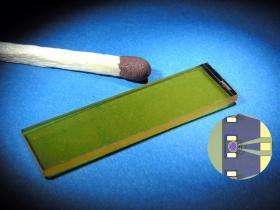Glass fibers instead of copper cables

Semiconductor technology is expensive. Novel optical microchips made of plastic are set to bring down the price of fiber-optic technology in future. Personal fiber-optic connections for private individuals and industrial enterprises may soon become a reality.
Fiber-optic systems transport data at an unrivaled speed. Until now, however, it has only been worth using them to interconnect large numbers of customers. They are too costly for individual connections or for networking machines in a factory. The reason is that the optoelectronic components that transmit light information, receive it, switch it and convert it into electrical signals are made of special inorganic materials such as semiconducting compounds or ceramics. This makes them very expensive. Researchers at the Fraunhofer Institute for Telecommunications, Heinrich-Hertz-Institut HHI in Berlin have developed an alternative made of low-priced plastics.
Using a simple centrifuge procedure, various liquid plastics are applied in several layers. The resultant material has a substrate, a light-conducting layer and a top coat. When the material is exposed to light and structured, tiny circuit paths form in the light-conducting layer. The light is carried in straight lines and also around bends in this layer. The researchers connect this polytronic component – a combination of polymers and electronics – to lasers and photodiodes. In this way, elements capable of transmitting and receiving light can be integrated in the plastic module. The component becomes able to distinguish light signals of different wavelengths and forward them separately, and even to split up a light signal over several different lines.
“This allows us to implement optical applications that have never before been viable due to their complexity and the high price of fiber-optic systems,” states Wolfgang Schlaak, head of the research project “Berlin Access / Fiber to the Home”, whose participants include not only the HHI researchers but also polymer experts from the Fraunhofer Institute for Reliability and Microintegration IZM in Teltow. Schlaak is referring particularly to the possibility of networking factory machines and equipment that are normally connected by copper cables. The new module would permit the optical signals to be sent from the central computer to several devices at the same time. Before this, each machine had to have a separate connection to the central control unit. And separate optical fibers were used – if at all – for incoming and outgoing data. The new polytronic components have brought cost-effective fiber-optic connections within reach. The fiber-optic cables would still have to be laid, but the new module would make receiving, transmitting and switching affordable.
Source: Fraunhofer-Gesellschaft





















